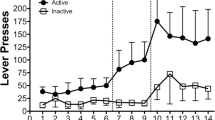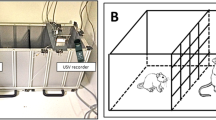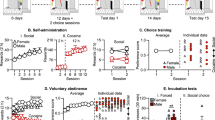Abstract
Rationale
One problem facing animal models of intravenous drug self-administration, particularly those examining social manipulations, is that subjects must be removed from the home environment and separated from cagemates during testing. This represents a limitation of animal models because it fails to capture the complex social environments in which drug use often occur.
Objectives
The aim of this study was to examine intravenous cocaine self-administration in isolated and socially housed rats, with the caveat that the socially housed subjects lived together 24 h/day, including during daily self-administration sessions. As a secondary aim, the study examined the impact of a companion that also self-administered cocaine versus a companion without access to cocaine.
Methods
Male rats were obtained at weaning and reared in isolated or pair-housed conditions for 6 weeks. Rats were then implanted with intravenous catheters and transferred to custom-built operant conditioning chambers that served as home cages for the remainder of the study. For some socially housed subjects, both rats had simultaneous access to cocaine; for others, only one rat of the pair had access to cocaine.
Results
Cocaine self-administration was facilitated in socially housed rats if both members of the pair had access to cocaine; however, cocaine self-administration was inhibited if only one rat of the pair had access to cocaine.
Conclusions
These data indicate that the self-administration behavior of a peer, not merely the presence of a peer, determines whether cocaine self-administration is facilitated or inhibited by social contact.




Similar content being viewed by others
References
Alexander BK, Beyerstein BL, Hadaway PF, Coambs RB (1981) Effect of early and later colony housing on oral ingestion of morphine in rats. Pharmacol Biochem Behav 15:571–576. doi:10.1016/0091-3057(81)90211-2
Allport F (1924) Social psychology. Houghton Mifflin, Boston
Andrews JA, Hops H (2010) The influence of peers on substance use. In: Scheier LM (ed) Handbook of drug use etiology: Theory, methods, and empirical findings. American Psychological Association, Washington, pp 403–420
Bahr SJ, Hoffmann JP, Yang X (2005) Parental and peer influences on the risk of adolescent drug use. J Prim Prev 26:529–551. doi:10.1007/s10935-005-0014-8
Bandura A (1962) Social learning through Imitation. University of Nebraska Press, Lincoln
Bandura A (1977) Social learning theory. Prentice Hall, Englewood Cliffs
Barker DJ, Root DH, Ma S, Jha S, Megehee L, Pawlak AP, West MO (2010) Dose-dependent differences in short ultrasonic vocalizations emitted by rats during cocaine self-administration. Psychopharmacol 211:435–442. doi:10.1007/s00213-010-1913-9
Bunch GB, Zentall TR (1980) Imitation of a passive avoidance response in the rat. Bull the Psychonomic Soc 15:73–75
Cohen J (1988) Statistical power analysis for the behavioral sciences. Routledge Academic, London
Cooper ZD, Truong YN, Shi YG, Woods JH (2008) Morphine deprivation increases self-administration of the fast- and short-acting mu-opioid receptor agonist remifentanil in the rat. J Pharmacol Exp Ther 326:920–929. doi:10.1124/jpet.108.139196
El Rawas R, Klement S, Salti A, Fritz M, Dechant G, Saria A, Zernig G (2012) Preventive role of social interaction for cocaine conditioned place preference: correlation with FosB/DeltaFosB and pCREB expression in rat mesocorticolimbic areas. Front Behav Neurosci 6:8
Ferguson SA, Frisby NB, Ali SF (2000) Acute effects of cocaine on play behaviour of rats. Behav Pharmacol 11:175–179
Fowler T, Shelton K, Lifford K, Rice F, McBride A, Nikolov I, Neale MC, Harold G, Thapar A, van den Bree MB (2007) Genetic and environmental influences on the relationship between peer alcohol use and own alcohol use in adolescents. Addict 102:894–903. doi:10.1111/j.1360-0443.2007.01824.x
Fritz M, El Rawas R, Salti A, Klement S, Bardo MT, Kemmler G, Dechant G, Saria A, Zernig G (2011) Reversal of cocaine-conditioned place preference and mesocorticolimbic Zif268 expression by social interaction in rats. Addict Biol 16:273–284. doi:10.1111/j.1369-1600.2010.00285.x
Gipson CD, Yates JR, Beckmann JS, Marusich JA, Zentall TR, Bardo MT (2011) Social facilitation of d-amphetamine self-administration in rats. Exp Clin Psychopharmacol. doi:10.1037/a0024682
Hadaway PF, Alexander BK, Coambs RB, Beyerstein B (1979) The effect of housing and gender on preference for morphine-sucrose solutions in rats. Psychopharmacol 66:87–91. doi:10.1007/BF00431995
Hake DF, Donaldson T, Hyten C (1983) Analysis of discriminative control by social behavioral stimuli. J Exp Anal Behav 39:7–23. doi:10.1901/jeab.1983.39-7
Hanson GR, Venturelli PJ, Fleckenstein AE (2011) Drugs and society, 11th edn. Jones and Bartlett, Burlington
Henning JM, Zentall TR (1981) Imitation, social facilitation, and the effects of ACTH 4-10 on rats' bar-pressing behavior. Am J Psychol 94:125–134. doi:10.2307/1422347
Herbert MJ, Harsh CM (1944) Observational learning by cats. J Comp Psych 37:81–95
Institute of Laboratory Animal Resources (2011) Guide for the care and use of laboratory animals. National Academies, Washington
John ER, Chesler P, Bartlett F, Victor I (1968) Observational learning in cats. Sci 159:1489–1491. doi:10.1126/science.159.3822.1489
Kandel DB (1986) Processes of peer influences in adolescence. In: Silbereisen RK, Eyferth K, Rudinger G (eds) Development as action in context: problem behavior and normal youth development. Springer, New York, pp 203–228
Kummer K, Klement S, Eggart V, Mayr MJ, Saria A, Zernig G (2011) Conditioned place preference for social interaction in rats: contribution of sensory components. Front Behav Neurosci 5:80
Larsen H, Engels RC, Granic I, Overbeek G (2009) An experimental study on imitation of alcohol consumption in same-sex dyads. Alcohol Alcohol 44:250–255. doi:10.1093/alcalc/agp002
Lerman DC, Vorndran CM (2002) On the status of knowledge for using punishment implications for treating behavior disorders. J Appl Behav Anal 35:431–64. doi:10.1901/jaba.2002.35-431
Miczek KA, Yap JJ, Covington HE (2008) Social stress, therapeutics and drug abuse: preclinical models of escalated and depressed intake. Pharmacol Ther 120:102–128. doi:10.1016/j.pharmthera.2008.07.006
Newman JL, Perry JL, Carroll ME (2007) Social stimuli enhance phencyclidine (PCP) self-administration in rhesus monkeys. Pharmacol Biochem Behav 87:280–288. doi:10.1016/j.pbb.2007.05.004
Pandina RJ, Johnson VL, White HR (2010) Peer influences on substance use during adolescence and emerging adulthood. In: Scheier LM (ed) Handbook of drug use etiology: theory, methods, and empirical findings. American Psychological Association, Washington, pp 383–401
Peartree NA, Hood LE, Thiel KJ, Sanabria F, Pentkowski NS, Chandler KN, Neisewander JL (2012) Limited physical contact through a mesh barrier is sufficient for social reward-conditioned place preference in adolescent male rats. Physiol Behav 105:749–756. doi:10.1016/j.physbeh.2011.10.001
Picotte DM, Strong DR, Abrantes AM, Tarnoff G, Ramsey SE, Kazura AN, Brown RA (2006) Family and peer influences on tobacco use among adolescents with psychiatric disorders. J Nerv Ment Dis 194:518–523. doi:10.1097/01.nmd.0000224927.64723.f6
Quigley BM, Collins RL (1999) The modeling of alcohol consumption: a meta-analytic review. J Stud Alcohol 60:90–98
Rademacher DJ, Kuppinger HE, Thompson KJ, Harrington A, Kaczmarek HJ, Kopish AJ, Steinpreis RE (1999) The effects of amperozide on cocaine-induced social withdrawal in rats. Behav Brain Res 99:75–80. doi:10.1016/S0166-4328(98)00074-6
Rademacher DJ, Schuyler AL, Kruschel CK, Steinpreis RE (2002) Effects of cocaine and putative atypical antipsychotics on rat social behavior: an ethopharmacological study. Pharmacol Biochem Behav 73:769–778. doi:10.1016/S0091-3057(02)00904-8
Richardson NR, Roberts DCS (1996) Progressive ratio schedules in drug self-administration studies in rats: a method to evaluate reinforcing efficacy. J Neurosci Methods 66:1–11. doi:10.1016/0165-0270(95)00153-0
Roberts DC, Bennett SA, Vickers GJ (1989) The estrous cycle affects cocaine self-administration on a progressive ratio schedule in rats. Psychopharmacol 98:408–411. doi:10.1007/BF00451696
Simons-Morton B, Chen RS (2006) Over time relationships between early adolescent and peer substance use. Addict Behav 31:1211–1223. doi:10.1016/j.addbeh.2005.09.006
Stairs DJ, Bardo MT (2009) Neurobehavioral effects of environmental enrichment and drug abuse vulnerability. Pharmacol Biochem Behav 92:377–382. doi:10.1016/j.pbb.2009.01.016
Strobel MG (1972) Social facilitation of operant behavior in satiated rats. J Comp Physiol Psychol 80:502–508. doi:10.1037/h0032997
Thiel KJ, Okun AC, Neisewander JL (2008) Social reward-conditioned place preference: a model revealing an interaction between cocaine and social context rewards in rats. Drug Alcohol Depend 96:202–212. doi:10.1016/j.drugalcdep.2008.02.013
Zentall TR, Akins CK (2001) Imitation in animals: evidence, function, and mechanisms. In: Cook RG (ed) Avian visual cognition. Cyberbook in cooperation with Comparative Cognition Press
Acknowledgments
The author would like to thank Dr. David Roberts for valuable help in designing and pilot testing the operant conditioning chambers, Kimberly Lang for excellent technical assistance, Chris van Rooyen for instrumentation support, Amy Sullivan for expert animal care and maintenance, and the National Institute on Drug Abuse for supplying the study drug.
Conflict of interest
The author reports no conflicts of interest.
Author information
Authors and Affiliations
Corresponding author
Additional information
This study was supported by the National Institutes of Health (DA14255, DA027485).
Rights and permissions
About this article
Cite this article
Smith, M.A. Peer influences on drug self-administration: Social facilitation and social inhibition of cocaine intake in male rats. Psychopharmacology 224, 81–90 (2012). https://doi.org/10.1007/s00213-012-2737-6
Received:
Accepted:
Published:
Issue Date:
DOI: https://doi.org/10.1007/s00213-012-2737-6




